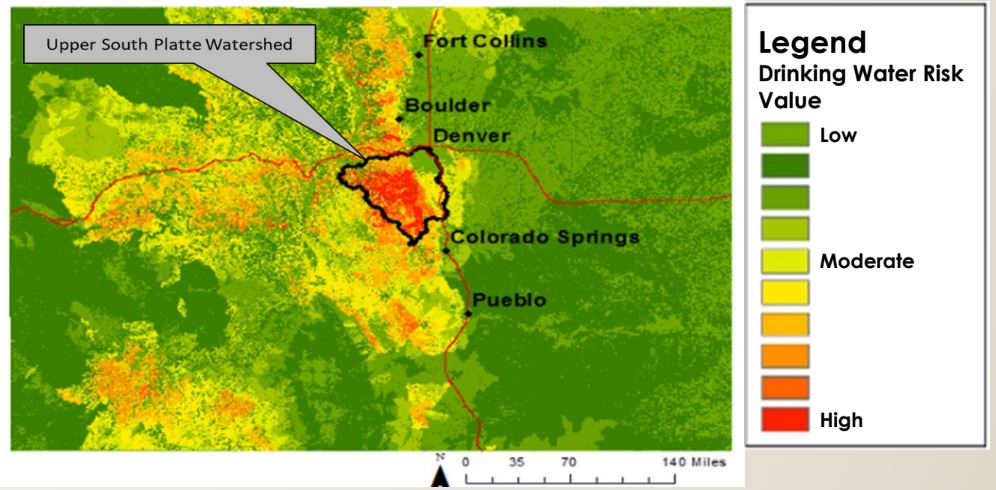Rocky Mountain Restoration Initiative 2022 Accomplishments
Our nation's forests and watersheds are facing increasing challenges that threaten everyday life in ways such as changing climates, wildfires, water shortages and invasive species. Land managers are having to rethink their strategies to address these challenges, which don't recognize physical boundaries. As a result, solutions that can be implemented across entire landscapes are needed to create forests that are healthy and resilient.
To overcome these challenges, the Rocky Mountain Restoration Initiative promotes collaborative efforts, and encourages its partners at the federal, state, tribal, and local levels to expand the scope of their forest restoration efforts. RMRI was established as a collaboration between the National Wild Turkey Federation and the USDA Forest Service, selecting Colorado as the pilot location to demonstrate the Forest Service’s Shared Stewardship strategy.
Partners within the RMRI are restoring landscapes in the Southwest, Upper Arkansas and Upper South Platte regions of Colorado. The goal is to restore 310,000 acres of public and private lands in the Southwest, 30,000 acres of public and private lands in Upper Arkansas, and 75,000 acres of public and private lands in Upper South Platte.
Southwest Colorado
In 2019, RMRI partners unanimously agreed to concentrate their initial combined efforts on Southwest Colorado. In 2022, the RMRI landscape in this area received a total investment of $11,949,786 for restoration work, with $4,201,761 of the total being non-federal funding from various sources. Volunteers from the Wildfire Adapted Partnership, the San Juan Mountains Association and the City of Durango contributed 19,935 hours of their time—which is equivalent to $597,053. This funding and volunteer support allowed over 100 projects and supporting activities to be completed on public, private, state, and tribal lands in 2022. As we look back on the accomplishments and progress made, we can celebrate the successes achieved through these collective efforts.
RMRI created a 10-year goal to treat 310,000 acres in the Southwest landscape; 290,000 of those acres on federal lands and the remaining 20,000 acres on private lands. RMRI Partners aim to treat approximately 29,000 acres of federal land and 2,000 acres of private land annually. Additionally, a goal was created to restore 93,000 acres of public and private lands in the first three years.
The progress has been significant, with 13,734 acres of public land restored in the San Juan National Forest and U.S. Bureau of Land Management lands, and 748 acres of private land restored in 2022. The restoration efforts will improve forest health, mitigate large fire sedimentation impacts to key watersheds, restore ecosystems, improve habitat and reduce hazardous fuels to protect communities and prepare the landscape for fire.
Additionally, the RMRI efforts resulted in the restoration of 2,967 acres of water on public and private land, as well as the mitigation of 9,717 acres to minimize the impact of catastrophic wildfires on surrounding communities.

Upper Arkansas
The Upper Arkansas landscape encompasses Chaffee and Lake Counties, which are home to Colorado's largest river basin.
In 2020, the Envision Forest Health Council in Chaffee County formulated a 10-year plan aimed at reducing the threat of severe fires to community assets through targeted forest treatments spanning up to 30,000 acres by 2030. As of the end of 2022, a total of 5,158 acres of public and private forest land have been treated, and $23 million has been raised for future forest planning and treatment projects. Furthermore, 1,098 private landowners have acted to enhance wildfire resiliency in the county.
In Lake County, 155 acres of private land have undergone treatment to mitigate wildfire threats to the community. In 2022, the Lake County community, in collaboration with citizens and a Community Wildfire Protection Plan Leaders Team, developed an updated version of the Community Wildfire Protection Plan. The primary objective of the updated plan is to decrease the overall risk to the community's assets by approximately 50% within a 10-year timeframe through prioritized treatment of specific acres.
Upper South Platte
The Upper South Platte watershed is a crucial water source, providing 80-90% of the water supply for the Denver and Aurora metro areas, serving around 3 million residents. The Upper South Platte Partnership takes the lead in this region, bringing together government agencies, water providers, nonprofit organizations, and academic institutions. Through collaborative efforts in 2022, a total of 2,274 acres of land, spanning private, local, state, and federal properties, received treatment as part of shared stewardship projects. Additionally, four fire protection districts conducted 292 home inspections, and 930 properties participated in chipping programs. The Forest Service also burned 305 acres of slash piles, while $3 million in funding was allocated for new projects in the watershed, further supporting conservation efforts.

RMRI partners will continue their efforts to improve the key landscape of southwest Colorado through restoration work in 2023. On May 4, 2023, the U.S. Forest Service's Rocky Mountain Region was granted $46,709,453 to implement fuel breaks as part of the Wildfire Crisis Strategy implementation. The San Juan National Forest, which is part of the RMRI southwest Colorado landscape, will receive $13,150,000 to prepare 150,000 acres of land for prescribed fire through mechanical treatments. This funding will support the RMRI partners in achieving their shared values of restoring forests and habitat, protecting communities, supporting recreation and tourism, and ensuring clean and secure water in this focal landscape.
To learn more about the Rocky Mountain Restoration Initiative’s mission and ongoing projects, visit the website here.
